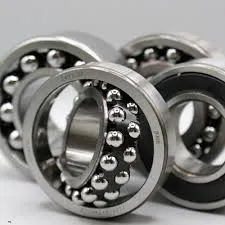
Nov . 01, 2024 11:38 Back to list
Understanding the Mechanics of Cylindrical Roller Bearings in Machinery Applications
Understanding Cylindrical Bearing Rollers
Cylindrical bearing rollers are crucial components in various mechanical systems, playing a pivotal role in reducing friction between moving parts and enhancing overall efficiency. These rollers are specifically designed to handle radial loads and are widely used in applications ranging from automotive and aerospace engineering to industrial machinery.
Design and Structure
Cylindrical rollers are characterized by their elongated, cylindrical shape, which provides a larger contact area with the raceway compared to traditional ball bearings. This design allows for greater load-carrying capacity and improved stability in high-load applications. The outer diameter of the rollers is typically larger than the diameter of the inner bore, providing an ideal surface for smooth rotation.
The surfaces of these rollers can be finished with various treatments to enhance durability and performance. Common surface treatments include hardening and grinding, which improve wear resistance and reduce operational noise. The materials used for cylindrical rollers often include high-carbon steel, stainless steel, and even ceramic composites, each selected based on the specific requirements of the application.
Functionality and Applications
Cylindrical bearing rollers excel in scenarios where heavy loads need to be supported. They are predominantly used in applications that require high rigidity and the ability to withstand axial loads, such as in gearboxes, electric motors, and conveyor systems. The ability of these rollers to operate under substantial loads makes them a popular choice in heavy machinery, such as forklifts, construction equipment, and more.
cylindrical bearing rollers

In addition to traditional uses, cylindrical rollers are also integral to modern technologies. They can be found in robotics, where precision and reliability are of utmost importance. Their ability to facilitate smooth movement is critical in applications that require exact positioning and high-speed operations, such as CNC machines and automated assembly lines.
Advantages
One of the significant advantages of cylindrical bearing rollers is their ability to handle higher loads compared to ball bearings of similar size. The line contact between rollers and raceways reduces the stress concentration, thereby prolonging their lifespan. Additionally, cylindrical rollers offer lower friction, which translates to energy savings and reduced heat generation during operation.
Moreover, the ease of assembly and disassembly makes cylindrical rollers a favorable option in maintenance-heavy industries. Their straightforward design facilitates quicker repairs, minimizing downtime and costs associated with equipment failures.
Conclusion
Cylindrical bearing rollers are indispensable in numerous industrial and mechanical applications, effectively enhancing performance and reliability. Understanding their design, function, and advantages is crucial for engineers and manufacturers aiming to optimize their machinery. As technology advances, the demand for more efficient and durable bearing solutions is likely to grow, positioning cylindrical bearing rollers at the forefront of engineering innovation.
Latest news
-
Premium Deep Groove Ball Bearings | High Speed & Reliability
NewsAug.29,2025
-
Durable Scaffolding Clamps - Secure & Reliable Tube Connectors
NewsAug.28,2025
-
Common Failures in Thrust Ball Bearings and Solutions
NewsAug.22,2025
-
How Tapered Roller Bearings Can Take Shock Loads
NewsAug.22,2025
-
Angular Bearings in High-Precision Spindles
NewsAug.22,2025
-
The Impact of Misalignment on Cylindrical Roller Bearing Performance
NewsAug.22,2025
